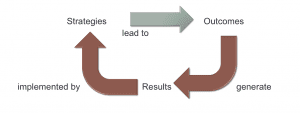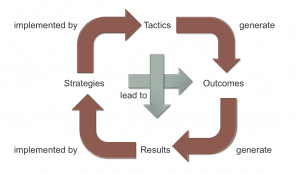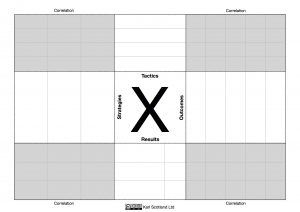There is a model for Strategy Deployment that sits behind the X-Matrix that is worth explaining in more detail as a way of understanding why it is designed the way it is, and how to use it. It is built around describing four types of elements – which I call results, strategies, outcomes and tactics – and how they fit together.
Before we start, lets get the George Box aphorism out of the way:
All models are wrong; some models are useful
Results
Results represent the organisational impact you want to have. They are lagging indicators, success or failure only being declared at the end of the journey. They usually reflect the nature of the business and its economics.
The Results are implemented by Strategies
Strategies
Strategies are constraints which guide how you achieve the results. They are enabling, allowing a range of possible solutions (as opposed to governing, limiting to a specific solution). Thus they guide decisions on where to focus attention (and hence also where not to focus attention).
The Strategies lead to Outcomes
Outcomes
Outcomes provide evidence that the strategies are working. They are leading indicators of whether the results can be achieved ahead of time. They describe the capabilities that the organisation requires in order to be successful.
The right Outcomes will generate the successful Results.
Of course the Strategies don’t directly lead to Outcomes. Some form of action has to take place. Thus the Strategies are actually implemented by Tactics.
Tactics
Tactics are the activities that take place to implement change. They are experiments which test hypothesis on how to achieve the outcomes. The represent the investments in the improvement work that is being done.
Therefore, it is the Tactics that generate the Outcomes and ultimately lead to the Results.
For change to be successful, there should be a correlation between the various elements in this model (and it should be remembered that correlation is not causation). Each element will have some level of contribution to another. This will range from strong or direct, to weak or indirect, or there may sometimes be none. You could also say that the correlations are Probable, Possible, or Plausible. All together there should be coherence (albeit messy) to the way all the elements fit together.
By starting with Results, moving on to Strategies and Outcomes and leaving Tactics until last, there is a greater chance that the Tactics chosen are ones which do implement the Strategies and generate the Outcomes. The intent is to avoid premature convergence or retrospective coherence when identifying the Tactics. It is very easy to hastily jump to the wrong conclusions about what the Tactics should be, and then justify them based on the Strategies.
Even if you don’t use the X-Matrix explicitly, understanding this model can be useful for asking questions about change and improvement.
- What end results are you hoping to achieve?
- What are your strategies to deliver them?
- What intermediate outcomes will show you are on the right path?
- What tactics are you using to move forward?
- How do all these pieces fit together?
If you can answer these questions, then you should be able to populate an X-Matrix. I will work through an example in an future post.




